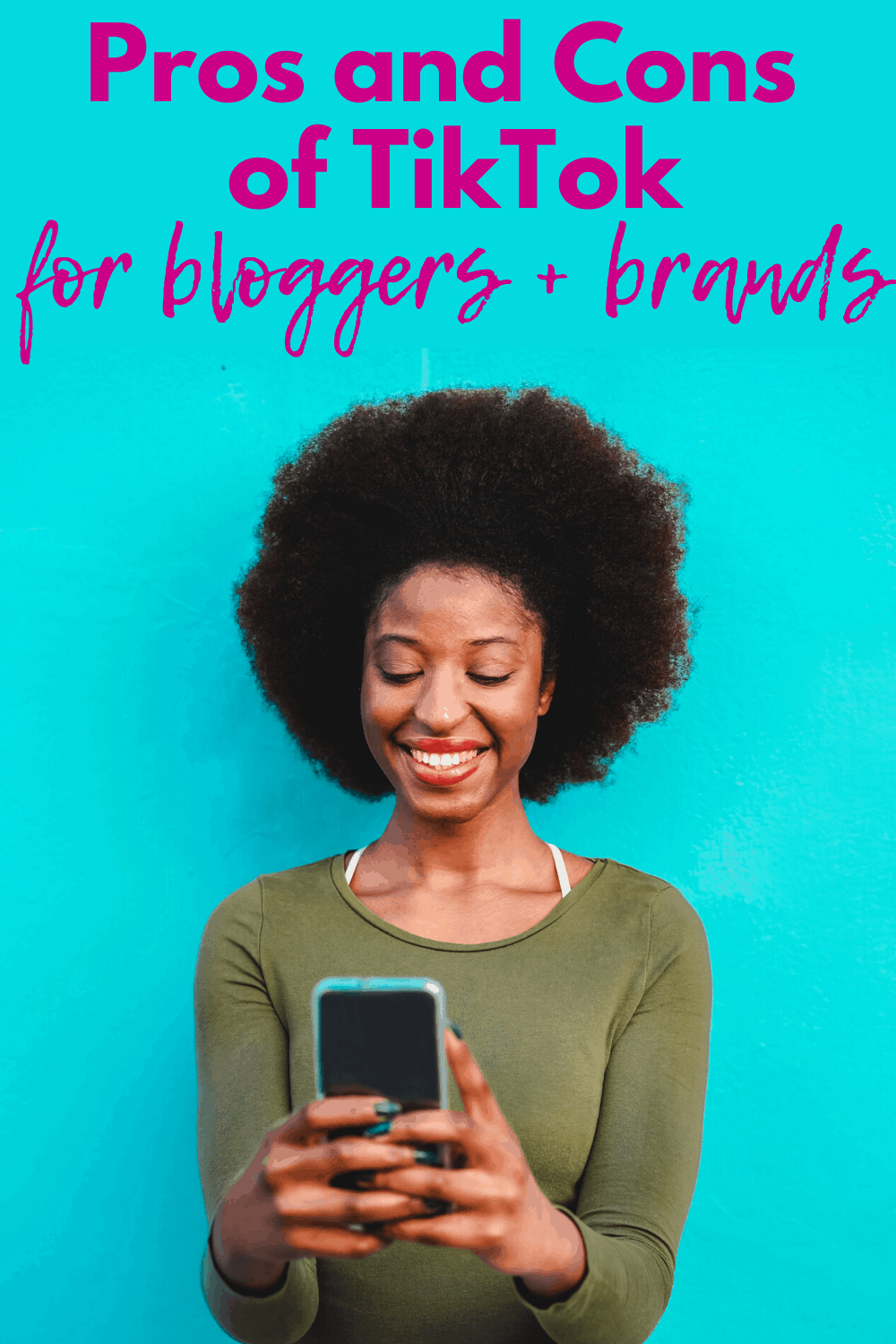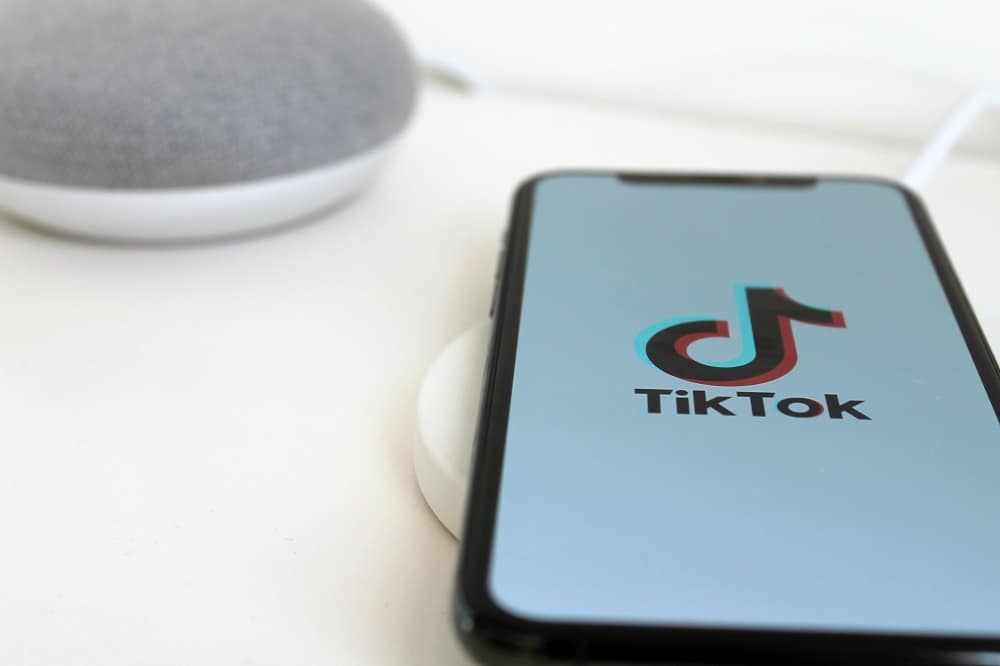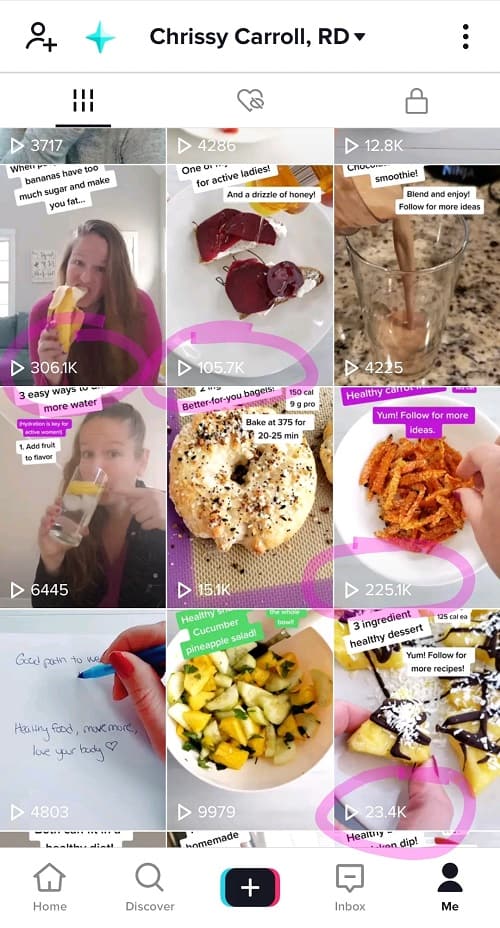
Pros and Cons of TikTok for Bloggers and Brands
If you’ve been following the social media trends the last year, you probably know that TikTok has exploded in popularity. But is this platform useful for bloggers and businesses? What are the pros and cons of TikTok? Find out everything you need to know in this post!
What is TikTok?
TikTok is a social networking app focused on short-form video content. Videos on the platform include lip synching, dancing, educational content, storytelling, and more. Similar to other social networking sites like Instagram and Facebook, users can like, comment on, and share videos. Users can also follow profiles of those from which they want to see more content.
The app is owned by the Chinese company ByteDance. The app was first launched as Douyin in China, and later TikTok was launched in worldwide markets (after merging with musical.ly). Douyin and TikTok are very similar apps, owned by the same Chinese company, but they run separately from each other on different servers due to different restrictions on content in the Chinese version of the app.
How can you leverage TikTok for business?
As a blogger or brand, TikTok provides a unique and creative outlet to share content. Brands can drive awareness to their products by featuring product use cases and storytelling surrounding their products / ideal clients. They can also follow trends on TikTok and jump on quickly to create engaging content.
We know that younger generations want to feel more of a connection to a brand; more like the brand understands them. This is an excellent way to develop that relationship.
Along the same lines, bloggers can utilize TikTok as another extension of their own brand. Similar to Instagram, TikTok is generally not an amazing traffic driver – though if you have a video go viral with hundreds of thousands of views, you can certainly expect a bit of a traffic boost to your link in your bio.
However, even if it doesn’t drive a lot of traffic, it can be a great place to showcase content that you do on your blog or other social channels. You can also switch up the link in your profile to affiliate products you are featuring, and try to drive sales to them.
And even more so, it can be a great place to pitch sponsored content for brands. For example, I’ve spent this summer working on a series of TikTok videos for one of my brand partners and it was an excellent contract for me. The brand also received many more impressions and likes on the TikTok videos than they would have on my Instagram profile.
Pros and Cons of TikTok
Of course, the app isn’t without controversy or questions about its effectiveness. Here’s an overview of the current pros and cons of TikTok as a social media platform:
Pros
Active users are growing – and you can jump in before it’s saturated.
TikTok is experiencing unprecedented growth, which makes it an excellent time for you to jump in. For example, eMarketer reports that in October 2019 there were 27 million US users on TikTok. Fast forward to March 2020 and that number sits at 52 million US users.
Even so, the app continues to grow and many are still being introduced to it. By jumping in now, you have a chance to grow your following before it gets overly saturated (think pre-2016 Instagram). You have a far better chance of growing your following now than if you wait two years and jump in then.
Fun, quick, and off-the-cuff.
Unlike Instagram where there is a pressure to have a certain aesthetic and have “perfect” photos and videos, TikTok offers a refreshing dose of off-the-cuff, less-polished video. Just play around in the app for a bit, and then jump in!
It’s recommended that you start with videos around 8 to 15 seconds. Average watch time is one of the most important factors governing distribution of your videos, so starting with shorter videos in this range makes it more likely that users will watch them and not scroll past. I bet it also feels a little less intimidating when you know you only have to create something 10 seconds long!
As you become familiar with the app, you’ll notice there are also lots of filters and effects that you can use to add a little extra something-something to your videos. And of course, you can also pay attention to the viral challenges and trends in the app (don’t worry, some are easy to follow along with!).
Viral potential.
Of all the social platforms, TikTok provides the “easiest” opportunity to experience a viral post. Easiest is in quotes, as it doesn’t mean you can throw together a shoddy video that has no hook or storyline. Bad or boring content will be bad or boring no matter which platform it’s on.
But if you put the time into creating something great; something that catches your audience’s eye and keeps them watching – your videos could easily hit 100K+ views even when you only have a few hundred followers.
That’s because (almost) every single video that is posted to TikTok goes to the “for you” page, where TikTok monitors for signals like total watch time, shares, comments, likes, and follows. If a video is deemed to do well with the audience it’s showing it to, TikTok may continue to push it out and help it go viral.
*Almost is in parentheses because there are occasions where people end up shadow-banned from the for you page, but that’s rare.
Here’s an example of the reach of a few of my videos from a couple months ago. To give perspective, my account only has about 8,000 followers right now:
Ability to go live.
Once you hit 1000 followers, you have the ability to go live on your account. This can be another great way of connecting with your audience.
For example, a fitness coach might be able to offer a live workout, while a nutrition blogger might do an open-ended Q&A session. Or a food brand might offer a “behind-the-scenes” live of their headquarters and answer questions along the way.
Just like going live on other platforms, there are a ton of ways to approach this.
Repurpose videos to other platforms.
When you create these videos in TikTok, you can often repurpose them to other platforms. Because it’s vertical, it works very well for Instagram stories and for Pinterest.
Keep in mind you may not be able to use the music choice on other platforms, though, due to copyright issues. When I create short-form recipe videos on TikTok, I often strip the sound from them and then repost them on Pinterest and Instagram stories. With Pinterest especially, it’s a great way to link back to my blog content (if the recipe is on my blog), or a great way to reshare sponsored TikTok content to reach a new audience and garner extra impressions.
Cons
Young demographic.
TikTok is primarily a young audience. According to Omnicore, about 41% of TikTok users are between the ages of 16 and 24. That can be a pro or a con depending on your brand/blog and marketing strategy. However, keep in mind two key points about this:
- Just because you don’t think this demographic would be interested in your content, doesn’t mean they aren’t. I’ve been surprised at the number of young adults that have connected with me on TikTok despite the fact that I’m a relatively lame 35-year old, haha.
- There is also a growing segment of 30- to 40-something moms on TikTok, which could be very relevant to your marketing plan even if the younger generation is not. Many moms joined TikTok during the lockdown phase of 2020.
Occasional unsavory material.
TikTok seems to be subject to more unsavory material than Instagram or Facebook, where things are typically pulled down pretty quickly if they violate guidelines.
While TikTok does have an AI filter in place that can catch obvious violence or sexual content, there are more subtle categories that can slip by this filter and remain on the app until a manual reviewer takes it down. For example, there have been a few instances of pro-anorexia content or pedophile “grooming” content that have made the news recently before being pulled on the app.
I’ve never come across anything unsavory in my time on the app (aside from some strong language, which doesn’t bother me). But clearly others have, so I think it’s important to put this out there. (As an aside though, this is a reason I wouldn’t recommend allowing young children to use it.)
Past censorship.
The app came under fire in early 2020 when internal policy documents were leaked that instructed moderators to suppress content created by those it deemed “ugly, poor, or disabled”. For example, some of the guidelines advised to suppress videos where there was “abnormal body shape, chubby, have obvious beer belly, obese, or too thin”.
TikTok claims these documents were made in an early attempt to prevent bullying, and were since retired and some were never used. As of late 2019, none of the policies are being used. However, clearly this is a fundamental flaw in the development of TikTok that such documents ever existed, and may be enough to push you away from using it.
Now I have personally seen more body diversity and acceptance on TikTok than many other platforms, but it could simply be because I engage with that type of content (as the algorithm will favor showing you the type of content you like and engage with).
Salty comments.
Y’all, I’m just going to say it – some of these kids are mean! As you’ll see in the screenshot below, TikTok seems to have a much larger issue with rude comments compared to other social platforms, likely because there’s even more anonymity behind it (many users just create a random username with no profile photo).
The good thing is, any engagement is theoretically good engagement, and helps drive your content’s success in the algorithm. Try to deal with rude comments by letting them roll off your shoulders or responding with some comedy.
If you’re sensitive to what others say though (as all of us can be), and find that it affects your mental health to read mean comments, TikTok may not be the place for you.
The security threat.
And finally, let’s address the elephant in the room that the media is always talking about – that TikTok could be a national security threat. The military has prohibited TikTok on phones and several government officials have called for an outright ban of the app in the United States.
Why the worries? Some U.S officials are concerned about the amount of data mining that occurs within TikTok, and that this data could be sent back to the Chinese government and potentially put US national security at risk.
Here are a few helpful things to keep in mind about this:
- TikTok has an office in the United States and maintains that user data has never been stored in China nor shared with the Chinese government. (Whether this is true or untrue is of course up for debate).
- TikTok has a US-based CEO, Kevin Mayer, who was the former head of Disney streaming services. Mayer oversees global operations for TikTok.
- TikTok has primarily been under fire this year after users noticed it could access and copy data from the clipboard on iPhones. However, this is a feature that happened to be in many apps. For example, did you know that ABC news, Fox News, Fruit Ninja, and Accuweather all also had this ability? (You can see the full list here.) For some reason, mainstream media focused only on TikTok and left out a whole bunch of other apps that had this security flaw. Does that mean the flaw is OK? Of course not. But keep in mind most of the apps you use on your phone are, in fact, monitoring what you do to some degree.
My takeaway from all of this? Unless you are working in intelligence, almost all of us do not know if TikTok is truly a security threat or is just a ploy in the political and media messaging.
My advice is to do what you’re comfortable with and what you feel is right. I personally (right now) feel comfortable using the app, given the information above. You may feel the exact opposite. That’s OK too.
If you don’t feel comfortable with data mining, then it’s a good idea to skip over TikTok and many other social apps. And if you have a very sensitive job – for example, a government position or a private contractor that exposes you to sensitive information – then it’s also probably a good idea to skip over TikTok on your phone (or any major social networking app for that matter).
In addition, it’s important to realize that should the US enact a nationwide ban on TikTok, that your hard work could all be for naught if you’ve completely switched focus to TikTok and ignored other platforms. This is why it’s important to diversify social media streams – and also to use them as much as possible to build your email list.
That said, I don’t think TikTok would let itself fall subject to a ban – I think before that would happen, they’d sell off the company (or at least the US portion of it) to one of the other social networking sites.
A Final Word
I hope this gives you good insight into all the pros and cons of TikTok. It’s totally a personal choice to use the app as part of your marketing strategy, and I hope I’ve shared enough of both the advantages and disadvantages that you can make an educated decision.
Have more to share? Have questions about this app? Feel free to share it below!








7 Comments
Tonya | the Writer Mom
I can definitely see where this platform could be helpful, but I’ve never been able to bring myself to sign up for tiktok, Snapchat, etc. It took a while to even sign up for Instagram, and I still have a hard time getting into it. 😂
Chrissy Carroll
Haha, it’s for sure difficult to take on yet another new platform! There’s so much to juggle all the time.
Heather Ritchie
I’ve really thought about using TikTok for my business so I’m so glad your wrote such a comprehensive post. I think it has great potential and people jumping on earlier will see a lot of progress, but it does have a lot of younger people. Thanks so much for the great information.
Chrissy Carroll
If you decide to jump in and try it out, let me know!
Pingback:
Gale
As former military who has friends and family who have worked in intel and IT security, this is a Hard Pass. I’m concerned at how you downplayed the military’s stance which is that active duty are told that their families should remove it from their devices. My son in IT security won’t touch it. I think the red flag here should be the size of Texas, not a cocktail pick.
Chrissy Carroll
Hi Gale. Thanks for your comment. I don’t think I downplayed it; I gave my opinion on it which is different than yours. As I mentioned in the article, those in sensitive jobs (government, intelligence, military) should avoid it. With no ban enacted on it, though, it seems to be here to stay and is certainly a personal decision whether to use. I feel comfortable with my choice to use it.